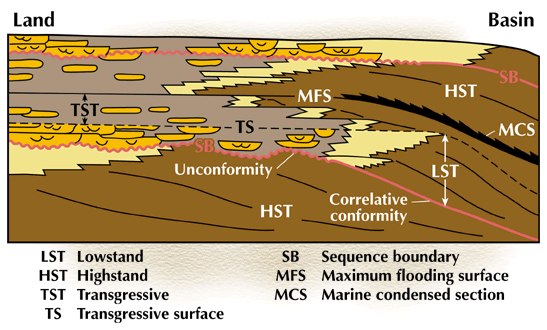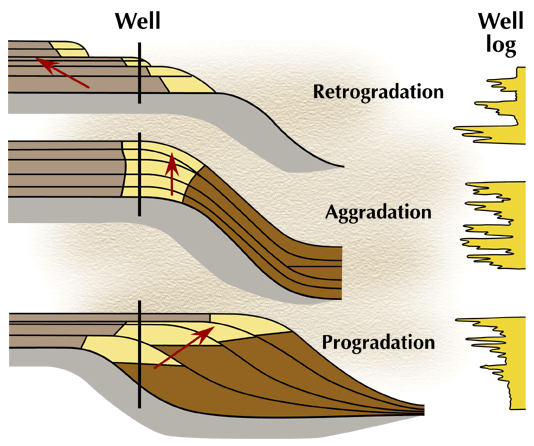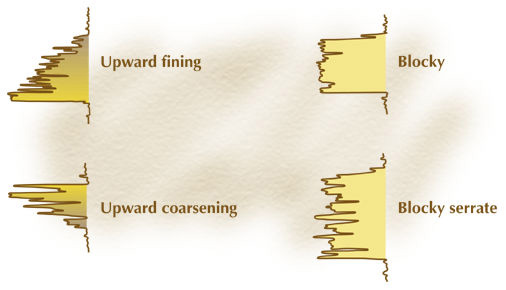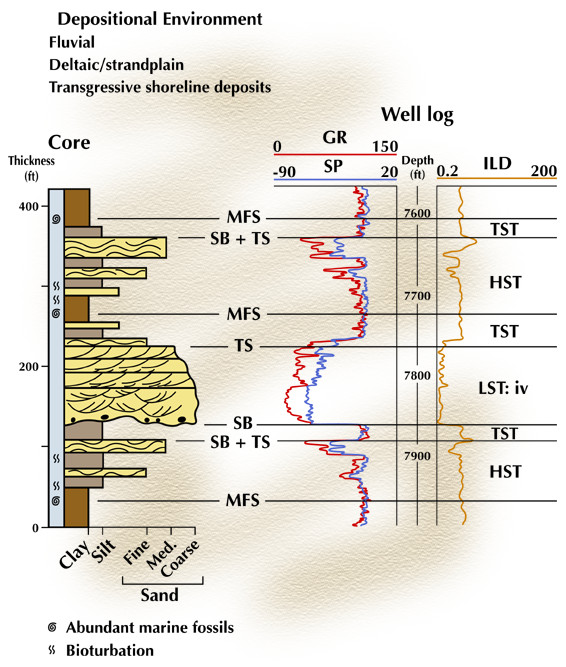 |
 |
| ©2000 AGI |

Systems Tracts
A complete sequence contains three systems tracts (in ascending stratigraphic order within the sequence): lowstand, transgressive, and highstand systems tracts (fig. 1 below). Each tract has its own distinctive set of sedimentary, depositional, and geometric characteristics that are partly represented in well logs. The sequence boundaries are significant subaerial and submarine erosion surfaces (unconformities) that record major drops in relative sea level and mark the inception of lowstand deposition.

Figure 1. Schematic depositional-dip profile illustrating the (1) generalized geometry and stratigraphic relations among the systems tracts and (2) locations of key surfaces within the sequence-stratigraphic framework. Modified from Posamentier and Allen (1999).
Lowstand Systems
Tract
The lowstand systems tract includes four depositional systems deposited
during periods of rapidly falling relative sea level (rapid decrease in
accommodation), subaerial and submarine erosion, subsequent low stillstand
(static accommodation), and slow initial sea-level rise (slow increase
in accommodation). During all four of these phases, the rate of sediment
supply is sufficient to maintain shoreline regression.
The four depositional systems are basin-floor fan, slope fan, prograding
wedge (= lowstand deltaic wedge), and on-shelf incised-valley fill. The
exercise cross section intersects an on-shelf stratigraphic succession:
the incised-valley-fill system will consequently be the focus of subsequent
discussion of the lowstand systems tract.
As initial, rapid, relative-sea-level fall occurs, river systems incise the sediments of the subaerially exposed coastal shelf, forming an unconformity where fluvial sands overlie marine facies. This unconformity and the time-equivalent surface of exposure in the on-shelf area form the sequence boundary. Seaward of the incising river system, basin-floor fans, slope fans, and early lowstand deltas (sometimes downward and seaward stepping) are deposited on a subsea conformable surface that is coeval with the sequence boundary. During subsequent slowing of relative sea-level fall, stillstand, and slow relative rise in late lowstand time, fluvial sediments within the incised valleys aggraded, and lowstand deltas prograded seaward (fig. 2 below).

Figure 2. Schematic representations of major stratal stacking patterns. Modified from Emery and Myers (1996).
The sedimentary fill of an incised-valley system is a record of late lowstand aggradation of fluvial deposits. The well log expression of an incised-valley-fill system reflects the variable lithology and geometry of component facies. The fill is, however, commonly dominated by sandstone facies, exhibiting a blocky, blocky-serrate, or pronounced upward-fining pattern on GR and SP log curves (figs. 3 and 4 below).

Figure 3. Representative examples of well log patterns of sandstone intervals. These examples are of actual GR logs from Miocene intervals from offshore Louisiana.

Figure 4. Core and well log data showing the relation among lithologic attributes, inferred depositional environments, and their expression on SP, GR, and ILD well log curves. Move the cursor over each of the three types of depositional environment to see that area highlighted on the core illustration. Outcrop photographs of the three systems tracts will appear in pop-up boxes when you click on the interval on the well log.
The basal boundary of the fill, the sequence boundary, is sharp on the log curves where it overlies shaly marine facies, reflecting the abrupt transition from prodeltaic shale below to sandstone above the unconformity. Where sandy valley-fill facies rest on an older, sandy, highstand delta or strandplain system, the sequence boundary lies within a sandstone section, making it more difficult to delineate. In those subaerially exposed areas of the shelf where no incised valleys exist, the sequence boundary is the surface of exposure. The subaerially exposed sediments are typically those of the underlying highstand facies deposited during the preceding sequence.